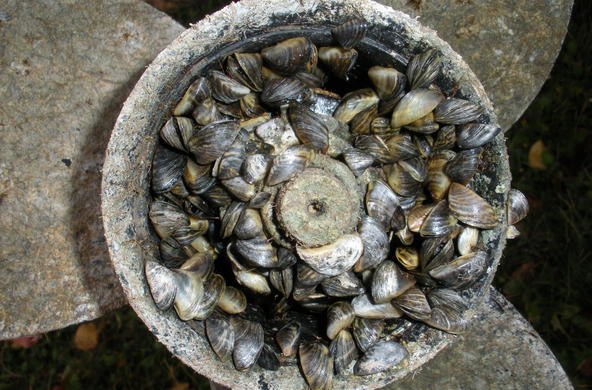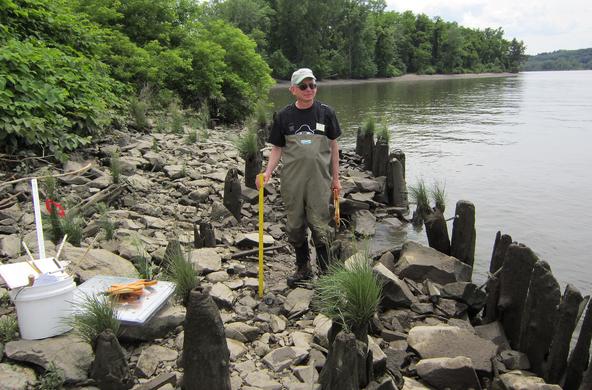As the height of New York’s recreational boating season approaches, state agencies and researchers have their eye on what could be hitching a ride on those boats: aquatic invasive species. Invasives such as zebra mussels, water chestnuts, and grass carp are already changing the ecosystems of waterways like the Hudson River. But that doesn’t mean it’s too late to prevent them from getting into other bodies of water.
Aquatic invasive species are plants, animals, diseases and bacteria that are not native to the waters of a region but have been introduced into it. When something not native to a region is introduced there, it often doesn’t have any natural predators, which can mean it’s capable of becoming dominant in an ecosystem.
There are many ways invasive species enter waters. A common one is that they’ll hitch a ride on a boat from one waterway to another. For that reason, the state has resources on how to properly drain, clean and dry your boat between uses.
Invasives can also travel the state’s waterways by themselves. For example, species introduced into Lake Erie can, and have, made their way into the Hudson via the Erie Canal.
Once there, invasives have unique ways of wreaking havoc on the waters they’re introduced into. Water chestnut, for example, creates a web of flora so thick that a boat cannot pass through it. That has real impacts for those who want to boat on areas of the Hudson.
Dr. David L. Strayer, freshwater ecologist for the Cary Institute, is an invasive species expert. Much of his research has focused on studying the long-term effects of zebra mussels in the Hudson River. In an interview this week, Strayer said zebra mussels were introduced to the Hudson in 1991. By the end of the following year, “the weight of zebra mussels in the Hudson exceeded all the other animals combined.”
Today, there are so many zebra mussels in the Hudson that they filter the river’s entire water store every four days. The result? All the small, edible stuff in the river has disappeared, consumed by zebra mussels. “Three-fourths of phytoplankton disappeared,” said Stayer. “That’s the base of the food web. So a bunch of the things that depend on phytoplankton declined or disappeared from the river.”
The impacts of invasives can be multi-layered, and they’re actually not always bad. In the case of the water chestnut, which Strayer acknowledges is certainly problematic for recreational boating, the way the plant interacts with the water and its ecology is intricate and has had some positive effects.
The plant is so dense that it creates pitch darkness below it — something researchers have confirmed with a light meter. That means that even on bright, sunny days, plants that would go through photosynthesis and release oxygen into the water aren’t able to do so. This leads to water that is not oxygenated enough. When new oxygenated water arrives from elsewhere through a tide, the oxygen-grabbing organisms in that part of the river zap the water of that oxygen within six hours. As a result, Strayer said, it’s hard for fish to live in those places.
However — and this is where a positive comes into play — certain bacteria will consume nitrates, an important coastal pollutant, in the absence of oxygen. They’ll only do it if there’s no oxygen present. That means that the conditions caused by the water chestnut in the Hudson, while negative for plenty of flora and fauna, are resulting in the removal of some nitrate pollution in the waterway.
Dense tangles of water chestnut plants can strangle the life out of a pond, but they also promote the removal of some nitrate pollution.
Does that mean it would be beneficial to introduce an invasive to a waterway in order to reap the positive benefits?
“In my mind, there’s no doubt about the question, ‘Do we deliberately introduce’ — no, we don’t,” said Strayer. “But if I were to give you a magic wand and say you can eliminate water chestnut from the Hudson, what I’m telling you suggests you may want to think about it. More recreational access and better access for fish? Or less nitrate pollution?”
Other impacts of aquatic invasives
The impact of invasive species isn’t just ecological. According to the U.S. Geological Survey, invasives cause $100 billion in damage each year to the U.S. economy via crop decimation, clogging of water facilities and waterways, wildlife and human disease transmission, threats to fisheries, increased fire vulnerability, and adverse effects for ranchers and farmers. In New York state, those effects add up to an estimated $500 million in repair costs and lost revenue.
Strayer said an organized federal response and management system would be the best approach to tackling aquatic invasives, but that isn’t happening anytime soon. Instead, states, or sometimes compendiums of states, have to take on the matter themselves, and their focus should be on prevention. Strayer says prevention is much more effective than trying to manage, mitigate or eradicate species post-establishment.
“It appears Elon Musk isn’t going to buy Twitter,” said Strayer. “So if Elon Musk instead came to me and said, ‘Dave, I’m going to give you $10 billion to get zebra mussels out of the Hudson,’ I don’t think I could do it. At least not without killing everything else in the river. We just don’t have a lot of tools for these invasives once they’re established.”
New York has a detailed management plan, adopted in 2015, and engages the public annually through education and on-the-ground contact about how to prevent the spread of invasives. Boat stewards are available for public assistance throughout the state, and boaters are able to access free high-temperature washes at a range of decontamination locations. More information on how the state calls on citizens to help prevent introducing invasive species can be found on the DEC’s website.






